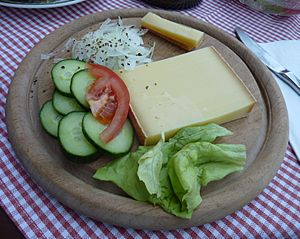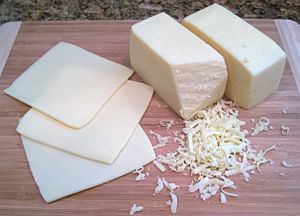List of German cheeses facts for kids
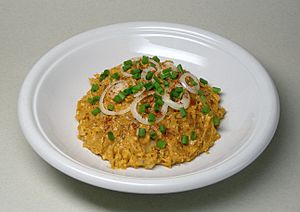
Cheeses are a big part of what people eat in Germany, both now and in the past. You'll find cheese in many different German dishes. Germany actually makes about one-third of all the cheese produced in Europe! That's a lot of cheese!
Contents
German Cheeses
Allgäuer Bergkäse
This cheese is made in a place called Allgäu. It uses milk straight from cows that hasn't been pasteurized. It's then aged for at least four months. This gives it a smooth texture.
Allgäuer Emmentaler
Also from Allgäu, this cheese is made from unpasteurized cow's milk. It's aged for more than three months and has a firm texture. Because it has a special protected name, this cheese can only be made in the German state of Bavaria.
Altenburger Ziegenkäse
This is a soft cheese made from cow's milk and goat's milk. It has caraway seeds mixed into the cheese. The outside of the cheese has a white mold, like Camembert. This cheese also has a special protected name, so it can only be made in certain areas like Altenburger Land and Leipzig.
Backstein
This cheese is similar to Limburger. It gets its name because it's shaped like a brick!
Bergader
This cheese is like the famous Italian Gorgonzola or French Roquefort, but it's made in Germany.
Bonifaz
Bonifaz is a soft, white mold cheese.
Butterkäse
Its name means "butter cheese" in German. It's a semi-soft cheese made from cow's milk. It's quite popular in Germany and other German-speaking countries.
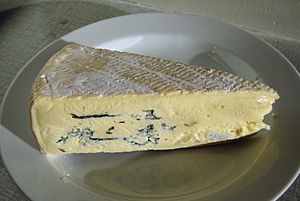
Cambozola
This cheese was invented around 1900. A large German company called Champignon started making it for the whole world in the 1970s. It's a mix of two famous cheeses: Camembert and Gorgonzola. That's how it got its name!
Edelpilzkäse
Edelpilzkäse is a fine blue-veined cheese. It has a pale, creamy color. It's similar to Roquefort but tastes milder because it's made with cow's milk. Tiny mold spores are mixed with the cow's milk. This mold grows inside the cheese, making the blue lines you see and giving it a tangy taste.
Handkäse
Handkäse is a special German cheese from places like Frankfurt am Main and Darmstadt. It's a sour milk cheese, similar to Harzer. It gets its name because it was traditionally shaped by hand.
Harzer
This is another sour milk cheese. It's made from low-fat curd cheese and has very little fat, only about one percent! It comes from the Harz mountain region.
Hirtenkäse
Also called "herder's cheese," this is a hard, golden-colored cheese. It's made from cow's milk in the Allgäu area of Southern Germany.
Hohenheim
Hohenheim is a soft cheese that is made in a round shape.
Kochkäse
Kochkäse is a runny sour milk cheese. It's made from quark, butter, baking soda, salt, and caraway seeds.
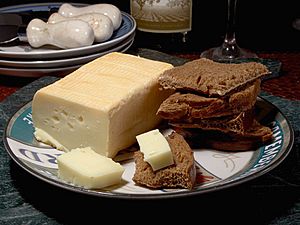
Limburger
This cheese was first made in Belgium by monks. Germany started making it in the 1800s.
Milbenkäse
This is a very special cheese made from quark. It's unique because tiny cheese mites help in its making! Today, it's only made in the village of Würchwitz in Germany.
Milkana
Milkana is a type of processed cheese.
Nieheimer
Nieheimer is a sour milk cheese. It's made in and named after the town of Nieheim in Germany.
Obatzda
Obatzda is a delicious cheese spread from Bavaria. It's made by mixing two-thirds of an aged soft cheese, usually Camembert, with one-third butter.
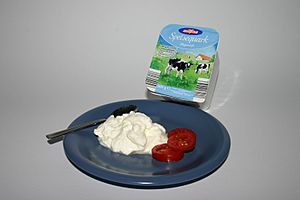
Quark
Quark is a fresh, mild cheese. In Germany, you can buy it in small tubs. It comes in different types, like Magerquark (very low fat), "regular" quark (20% fat), and Sahnequark (creamy, 40% fat). You can also find it sweetened with fruit, like a yogurt dessert.
Rauchkäse
Rauchkäse is a German smoked cheese. It's known for being semi-soft with a smoky brown outside. The most famous kind is called Bruder Basil.
Romadur
This is a cow's milk cheese with a strong taste. It's one of the most popular cheeses in Germany.
Spundekäs
Spundekäs is a spiced cream cheese. It comes from the Northern Rhenish Hesse region. People often enjoy it in wine houses with soft pretzels and local wine. It's usually made from cream cheese and quark, seasoned with salt, pepper, and paprika. It's a bit like Obatzda.
Tilsit cheese
Tilsit cheese is a light yellow, semi-hard cheese. It was first made in the mid-1800s by settlers from Switzerland.
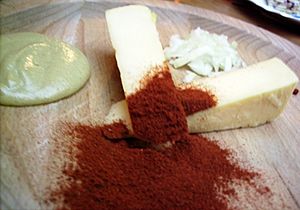
Weißlacker
Weißlacker means "whitewashed" in German because of its rind color. It's also known as Beer cheese. This cow's milk cheese started in Germany and is now known around the world. It's a strong-smelling and salty cheese that ripens on the surface.
Ziegel
Ziegel cheese is made from cow's milk.
Images for kids
-
Aged Milbenkäse
-
A plate of Obatzda, garnished with white and green onion
See also


